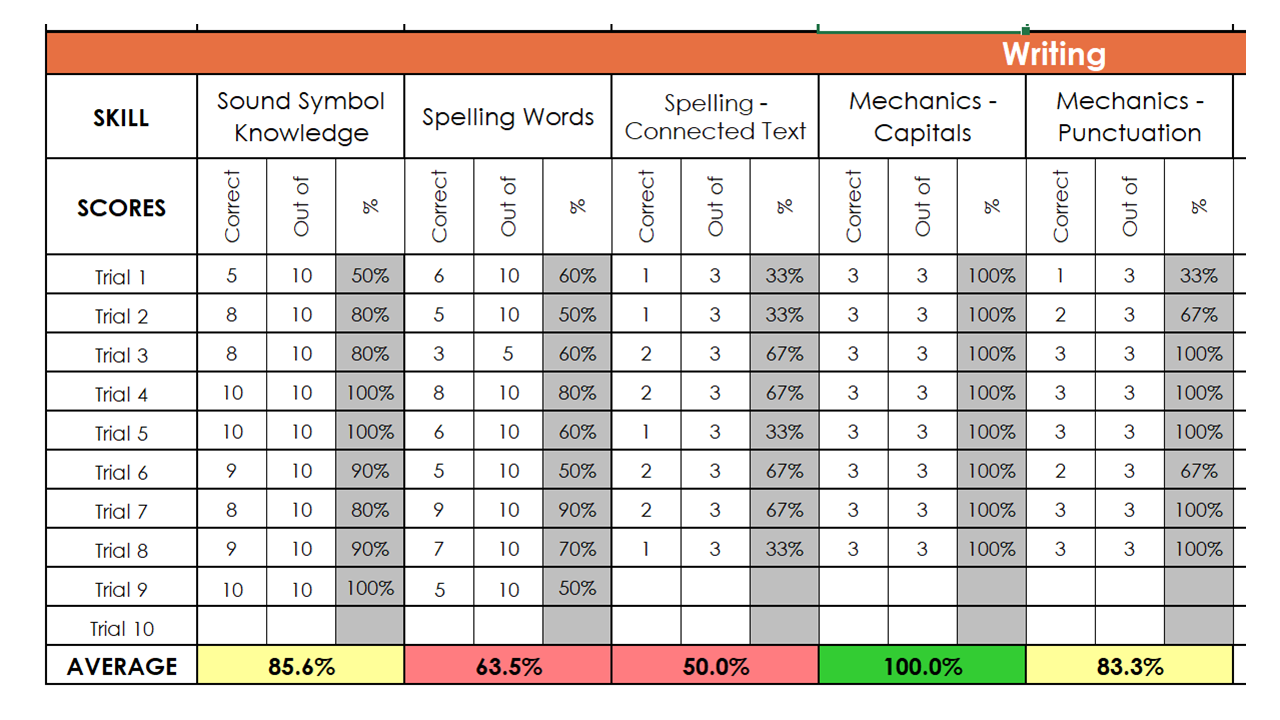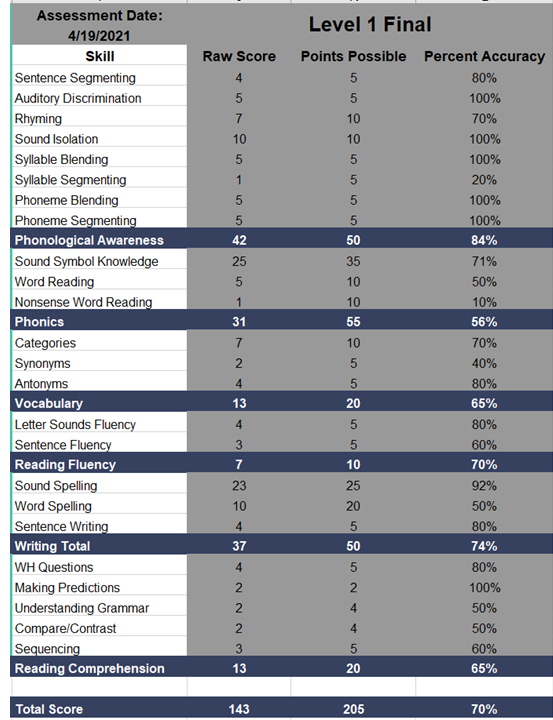The 3-Step Framework that Will Drive Your Intervention to Better Results
Hi friends,
For the last few weeks, we have been looking at profiles of two students who continue to struggle after four years of intervention through an IEP in the hopes of discovering why so many students continue to struggle and how we can change this trajectory for them.
Today, we are going to continue talking about “Student B.” If you haven’t read about her yet, you can read about her IEP and her scores >>here.<<
When we looked at her IEP last week, we posed questions about why all of her needs weren’t being addressed, how her goals were being measured, and what she was ultimately working on. These questions are not uncommon when looking at students’ IEPs.
Luckily, there is an easy 3-phase approach to intervention that will allow all of us to change trajectories for students just like Student A and Student B.
We call this the Assess - Design - Implement Framework.
Let’s start with Phase 1: Assess.
When Student B came to see us, we looked through her data at school and standardized data and recognized a significant struggle across the board. Her iReady scores came back at a 1st-grade level and on a placement screener it was clear she did not know many of her blends, digraphs, and welded sounds.
Whenever we begin working with a student, we always start by looking at their standardized data and giving a baseline assessment to see where they are starting out. Here are her baseline scores.
Phase 2: Design
After looking at all of these scores, the following goals were written.
Student B will improve her reading and writing skills by receiving direct and systematic instruction in phonological awareness, phonics, vocabulary, reading fluency, reading comprehension, spelling, grammar, mechanics, and written content development from a baseline of 64% to 90% accuracy or greater by completion of Level 1 of the SMARTER Reading & Writing Intervention program (you can use any time frame here but for us, this usually occurs in 6-month intervals).
Key Measures:
Phonological Awareness - Student B will improve her phonological awareness skills (including blending, segmenting, and isolating words, syllables, and sounds) in order to support foundational reading and spelling ability from a baseline of 68% to 90% accuracy or greater by completion of Level 1 of the SMARTER Reading & Writing Intervention program.
Phonics - Student B will improve her ability to recognize specific orthographic patterns and decode closed syllable words containing blends and digraphs and nonsense words in isolation from a baseline of 64% to 90% accuracy or greater by completion of Level 1 of the SMARTER Reading & Writing Intervention program.
Vocabulary – Student B will be given strategies to improve her ability to identify categories, synonyms, and antonyms of common words from a baseline of 75% to 90% accuracy or greater by completion of Level 1 of the SMARTER Reading & Writing Intervention program.
Reading Fluency – Student B will be given strategies to improve letter-sound fluency and sentence reading fluency from a baseline of 60% to 90% accuracy or greater by completion of Level 1 of the SMARTER Reading & Writing Intervention program.
Reading Comprehension - Student B will improve her ability to answer WH questions, sequence a story, make predictions, understand grammar usage, and compare and contrast story elements to support reading comprehension from a baseline of 65% to 90% accuracy or greater by completion of Level 1 of the SMARTER Reading & Writing Intervention program.
Writing - Student B will improve her ability to tie sounds to specific letters, spell closed syllable words containing blends and digraphs, and utilize basic sentence structure with capitals, organization, and punctuation from a baseline of 56% to 90% accuracy or greater by completion of Level 1 of the SMARTER Reading & Writing Intervention program.
Notice how all of the goals are explicit, clear, and written in a way that everyone can understand. These also allow for the interventionist to know exactly what to work on each week. She can have activities and games prepped ahead of time that will target each of these areas so that this student is getting exactly what she needs.
This brings us to Phase 3 - Implement.
This student is seen twice per week, 60 minutes at a time. Lessons will often take two sessions to complete (a day of reading-based support with a key phonogram, and a day of writing-based support with the same phonogram). Lessons are presented in a systematic, cumulative, and explicit way like research tells us we should be doing.
Now, it isn’t enough to just go through these three phases once. To have truly effective intervention, we have to repeat this cycle again.
Assess
Halfway through the program, we will give a midpoint assessment. Student B looked like this.
Design
We then update the goals with a progress report to make sure things are moving in the right direction. If we notice some scores aren’t where we want them to be, this midpoint allows us to tweak and make adjustments as necessary.
Implement
We continue with weekly lessons. In each lesson, we are also taking data to make sure that we see how students are doing over time, not just in progress monitoring snapshots. Student B’s weekly data looks something like this.
We take data on all 5-Core components of literacy so that we have a very clear picture of where students need additional support.
We continue this cycle of assess - design - implement throughout our intervention.
Something we want to point out here - is that sometimes the data doesn’t appear to reflect rainbows, butterflies, and unicorns.
This isn’t bad. It doesn’t mean the interventionist or teacher is doing a bad job. The data simply tells us what is working for this particular child and what needs to change.
As we dig further into Student B’s most recent data, her scores look like this.
Now, many of her scores on this assessment have dropped. However, this gives us valuable information we can use to help her.
When a student is receiving intervention and the teacher/interventionist is doing everything right - we have to ask ourselves, “What else is going on here?”
If we look more at her scores, we see that many of the areas where she is struggling focus on struggles related to speech. Not articulation (which she received services for as a young child but was discharged) but expressive vocabulary.
Language is a building block for our students’ reading and writing abilities. This is why we are so passionate about SLPs offering literacy intervention services (you can read more about that here). Without strong language skills, students will continue to struggle with reading and writing, especially when it comes to vocabulary and comprehension.
If we look back at Student B’s evaluation, we see that while her receptive vocabulary was strong, she struggled significantly with expressive vocabulary.
We now see that this is impacting her ability to express herself in her writing, as well as in her vocabulary and comprehension skills.
This information is critical to her overall success because now we have a clear next step. We know that we need to support her expressive vocabulary and that a Speech-Language Pathologist may be the best person to do this. This means that in her IEP, we should be recommending goals around speech, and/or, her family should consider private speech services.
The other thing that we notice with her final scores, is that they are not all lining up with her weekly data. On this assessment, it appears as though she is reading with only 56% accuracy. In her weekly lessons, her scores are much higher. Having this weekly data gives us more information that we can use when looking at the big picture of how this child is responding to intervention.
So, all of that being said - here are our key takeaways:
We need to follow an assess - design - implement framework for intervention to be effective (in a shorter amount of time)!
This student has spent 4 years on an IEP without getting the speech services that it appears that she needs. With the assess-design-implement framework, her interventionist was able to identify this in 6 months. She is also making great gains week to week, which her previous scores did not reflect.
The scores don’t always need to go up to show that you’re doing a good job.
Yes, of course, we want students to be making progress. When the testing scores don’t reflect this, however, we need to look deeper to figure out what is going on. It doesn’t mean that the instructor has done/is doing a bad job.
For more information about how you can tie all of this together, check out our How to Create SOR-Aligned Goals & Track Data. In this free workshop, you will learn how to use the data you already have to set appropriate goals, uncover the key to setting up your lessons to make data tracking easy and learn how to manage & organize your data. Plus, you’ll get a free data-tracking template!








